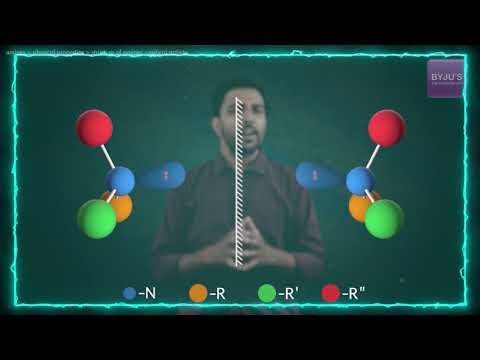The solutions uploaded at BYJU’S will enable the students to obtain a fair idea about the distribution of marks with respect to each topic. Practising these questions will help them understand the amount of preparation required to face the examination.

1) H(g) + e– ? H(g)–
2) Na(g) ? Na(g)– ? e–
3) Ar(g) + e– ? Ar(g)–
4) O–(g) + e– ? O(g)2-
Answer: (1)
H(g) + e– ? H(g)– is an exothermic reaction.


1) HCHO
2) Water
3) Eosin dye
4) Egg white
Answer: (4)
Surface theoretical egg white
1) [Ti (NH3)6]3+
2) [Co (OX)2 (OH)2]–
3) [Pd (gly)2]
4) [Fe (en) (bpy) (NH3)2]2+
Answer: (2)
[1] [Ti (NH3)6]3+ ? Ti3+ (3d1) ? ?? = v3 [2] [Co (OX)2 (OH)2]– (?0 > P) ? Co+5 (3d4) ? t2g4 eg0 [3] [Pd (gly)2] ? pd2+ (4d8) ? Square planarn = 0, ?? = 0, diamagnetic
[4] [Fe (en) (bpy) (NH3)2]2+Fe2+ ? 3d6 (t2g6 eg0) ? n = 0, ?? = 0

Answer: (2)
Rate of reaction ? stability of carbocation.

1) zero
2) Cv [T2 – T1]
3) – RT (V2 – V1)
4) – RT ln (V2/V1)
Answer: (1)
As it is free expansion against zero external pressure, work done = zero.

1) Silver and gold in proportion to their atomic weights
2) Silver and gold in equal mass proportion
3) only silver
4) only gold
Answer: (1)
Here the current is the same. Both metals are univalent and of the same concentrations. So, both will be deposited in proportions of their equivalent weight or atomic weight.
1) Helps in the secretion of histamine
2) Activates the histamine receptor
3) Inhibits the secretion of histamine
4) Inhibits the action of histamine receptor
Answer: (4)
The mechanism of action of “Terfenadine” (Seldane) is to inhibit the action of histamine receptors.
1) 9?1/5
2) 27?1/5
3) 36?1/5
4) 5?1/9
Answer: (1)
(1/?1) = R4 × (1)2 × {1 – [1/82]} = RH
(1/?2) = R4 × (2)2 × {[1/4] – [1/9]} = RH {5/9}
(?2/?1) = 9/5
?2 = (9/5) ?1


1) – 0.8?0
2) – 0.8?0 + 2P
3) – 0.4?0 + P
4) – 0.4?0
Answer: (4)
[CoF3(H2O)3] (?0 < P)CO3 + (3d6) = t2 g4 eg2
CFSE = [(-2/5) * 4 + (3/5) * 2] ?0
= – 0.4 ?0


Answer: (2)

1) [CrF6]3-
2) XeF4
3) BrF5
4) [Ni (CN)4]2-
Answer: (4)
(1) (CrF6)3– – d2Sp3
(2) XeF4 – Sp3d2
(3) BrF5 – Sp3d2
(4) [Ni(CN)4]2– ? dsp2
Question 17: In the following reaction sequence, [C] is:


1) Photochemical smog and ozone layer depletion
2) Photochemical smog and global warming
3) Global warming and photochemical smog
4) Global warming and acid rain
Answer: (4)
Environmental
Calcination Releases ? CO2 ? Global warming
Roasting Releases ? SO2 ? Acid Rain
Question 19: The incorrect statement(s) among (a) – (c) is (are):
(a) W(VI) is more stable than Cr(VI).
(b) in the presence of HCl, permanganate titrations provide satisfactory results.
(c) some lanthanoid oxides can be used as phosphors.
1) (a) only
2) (b) and (c) only
3) (a) and (b) only
4) (b) only
Answer: (4)
Fact
1) Ca
2) Be
3) Mg
4) Sr
Answer: (2)
Fact
Answer: 167
[0.1 × 1 + 0.2 × 2]/3 = 0.5/3 = (500/3) × 10-3 = 167Answer: 84297.47
(1/5) = e-Ea/300R/e-Ea/315R
(5) = e[Ea/R][(1/300) – (1/315)]
(Ea/R) [(15/(300 × 315)] = ln 5
Ea = 1.6094 × 315 × 20 × 8.314
Ea = 84297.47 J/mol
Answer: 10
(0.1/2) × (100/1000) = (1.43/[160 + 18x])
106 + 18x = 286
18x = 180
x = 10
Question 24: Consider the following equations:
2 Fe2+ + H2O2 ? x A + y B (in basic medium)
2 MnO4– + 6 H+ + 5 H2O2 ? x ‘C + y ‘D + z’E (in acidic medium).
The sum of the stoichiometric coefficients x, y, x’,y’ and z’ for products A, B, C, D and E, respectively, is _________.
Answer: 19
2Fe2+ + H2O2 ? xA + yB ? 2Fe3+ + 2OH–
2MnO4 – + 6H+ + 5H2O2 ? x`C + y`D + Z`E ? 2Mn+2 + 5O2 + 8H2O
x = 2 ; y = 2; x’ = 2, y’ = 5, z’ = 8
2 + 2 + 2 + 5 + 8 = 19
Answer: 2















Comments